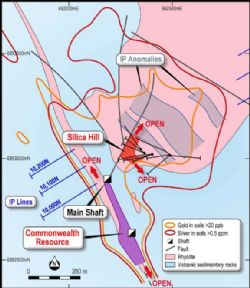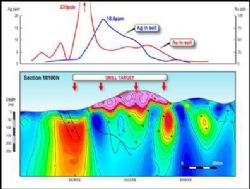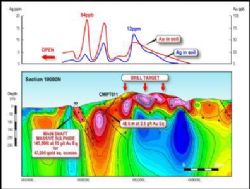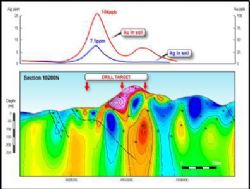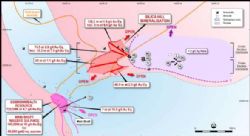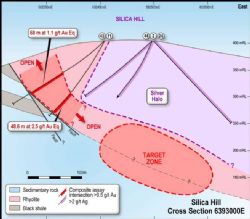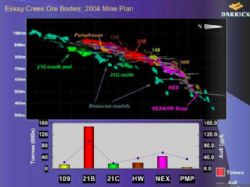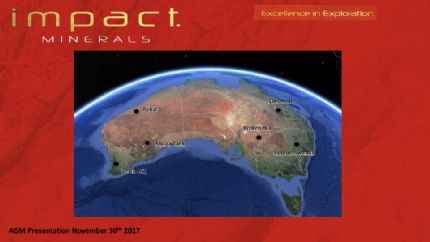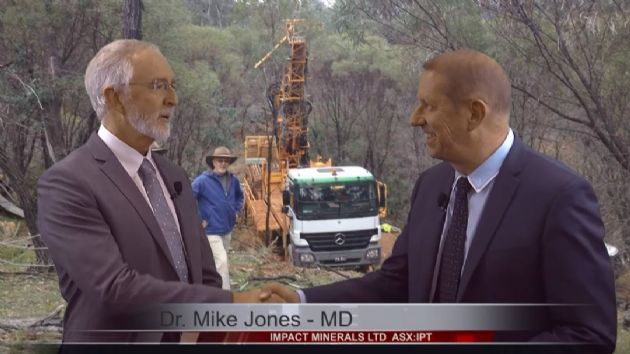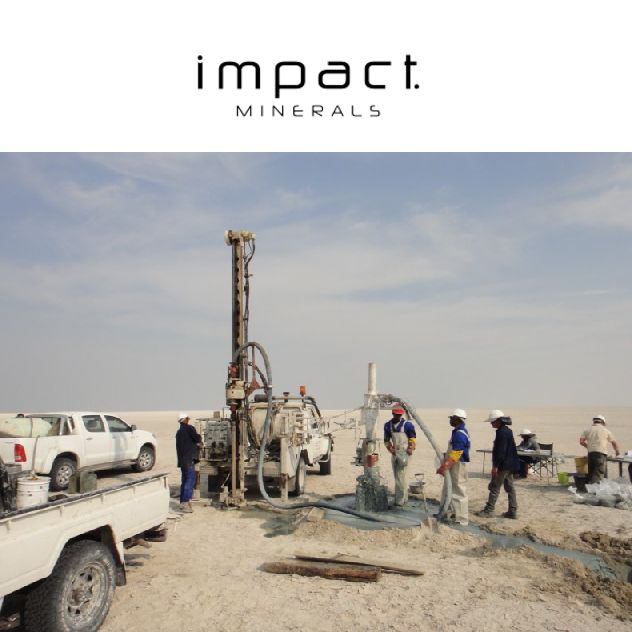 Priority Drill Targets for Gold-Silver at Silica Hill, NSW
Priority Drill Targets for Gold-Silver at Silica Hill, NSW
Perth, May 9, 2017 AEST (ABN Newswire) - Specific drill targets have now been identified with the potential to significantly expand the high grade gold-silver mineralisation discovered by Impact Minerals Limited ( ASX:IPT) at the Silica Hill Prospect, part of the 100%-owned Commonwealth Project 100km north of Orange, New South Wales (Figure 1 in link below).
ASX:IPT) at the Silica Hill Prospect, part of the 100%-owned Commonwealth Project 100km north of Orange, New South Wales (Figure 1 in link below).
The targets have been generated and prioritised for drilling from a detailed interpretation of three lines of Induced Polarisation (IP) chargeability data and from soil geochemistry data (Figure 2 in link below).
In addition a review of all of Impact's work over the past few years has now demonstrated strong similarities between the mineralised system at Commonwealth-Silica Hill and surrounding area to the very high grade Eskay Creek Mine in British Columbia, Canada (4 million ounces of gold, 180 million ounces of silver; Figure 5).
Drilling of the new targets at Silica Hill will test this geological model and will commence on receipt of statutory environmental approvals due in the next few weeks. Other targets at Commonwealth and Welcome Jack will also be tested.
At Silica Hill the new targets to be drilled occur on three specific traverses within a large area of up to one square kilometre which contains numerous undrilled IP and gold- and silver-in soil anomalies north of the small area drilled to date (Lines 10,000 mN, 10,100 mN and 10,200 mN, Figures 1 and 2 in link below).
All three traverses comprise coincident strong IP chargeablity and gold- and silver-in-soil anomalies.
Previous work by Impact has shown a strong correlation between IP chargeability anomalies and gold-silver sulphide mineralisation in drill holes.
On Line 10,000 mN the target area lies east of the current drilling and is 500 metres wide with peak soil geochemistry values of 50 ppb gold and 12 grams per tonne silver. These are of the same order as the soil geochemical anomalies over Silica Hill and Commonwealth on this traverse (Figure 2 in link below).
On Line 10,100 mN the target area is 750 metres wide with peak soil geochemistry values of 235 ppb gold and 18.8 grams per tonne silver.
On Line 10,200 mN the target area is 700 metres wide with peak soil geochemistry values of 104 ppb gold and 7.1 grams per tonne silver.
The size and strength of the IP anomalies and their coincidence with strong gold- and very strong silver-in soil anomalies is very encouraging for the discovery of further high grade gold and silver mineralisation.
Significant mineralisation has been intersected in six drill holes so far at Silica Hill and covers an area of 200 metres by 100 metres down to a depth of 120 metres below surface and with an average true thickness of at least between 50 metres and 70 metres. The mineralisation is open in all directions including up dip (Figures 1, 3 and 4 in link below).
Four drill holes out of the six have also returned gram-times-metre intercepts of more than 100 gram.metres. These are robust and significant results for potential bulk mining and indicate the potential to significantly increase the resources at the Commonwealth Project, which currently stand at 720,000 tonnes at 2.8 g/t gold, 48 g/t silver, 1.5% zinc and 0.6% lead (see announcement 19 February 2015).
In detail, these thick widths of mineralisation actually comprise numerous narrow veins and vein stockworks of high grade gold and very high grade silver hosted by the Silica Hill rhyolite that contain lower grade disseminated gold and silver. For example, Hole CMIPT046 returned an intercept of 41 metres at 2 g/t and 176 g/t silver from 61 metres including 30 individual assays of varying widths of between 2 g/t and 24 g/t gold and 12 individual assays with more than 500 g/t silver including (see announcements dated 5th December 2016 and 22nd February 2017)
1 metre at 12.2 g/t gold and 680 g/t silver including 0.3 metres at 23 g/t gold and 1,110 g/t silver;
1 metre at 5.3 g/t gold and 924 g/t silver;
1.7 metres at 3.8 g/t gold and 1,176 g/t silver; and
0.7 metres at 1.5 g/t gold and 855 g/t silver.
The Nature of the Mineralisation at Commonwealth-Silica Hill
Impact has amassed a considerable amount of geological data on the nature of the mineralised system at Commonwealth-Silica Hill and surrounding areas over the past two years.
All of this work, summarised below, has shown that the mineralisation belongs to a class of deposits known as "gold-rich VMS systems", a style that has only been widely recognised in the past 20 years.
The type-deposit of the gold-rich VMS systems is the well known Eskay Creek deposit in British Columbia, Canada which was mined mostly during the early 2000's. The deposit contained over 4 million ounces of gold and 180 million ounces of silver and contained numerous very gold and silver rich ore shoots as shown in Figure 5 over a vertical extent of at least 700 metres.
All of Impact's work shows that there are compelling similarities specifically to Eskay Creek in terms of the nature of the host rock, the style of mineralisation, the contained commodity and pathfinder metals and the high grades of individual units and veins of commodity metals.
Figure 5 also shows the depth of drilling to date at Silica Hill at the same scale as the Eskay Creek deposit for comparison. It is evident that there is scope for a significant discovery with further drilling.
The work done by Impact in reaching this conclusion has included the following:
- detailed field mapping and logging of diamond core to identify the principal rock types and the nature of the original submarine volcanic environment;
- petrographic studies of the mineralisation and host rock units to determine their relative timing relationships;
- detailed structural analysis of outcrops and diamond core to help identify the structural controls on mineralisation;
- geochemical studies that have helped define a halo of specific alteration minerals around the mineralisation and which are providing vectors to ore. These minerals include chlorite, sericite, K-feldspar and barite amongst others. The studies have included interpretation of handheld pXRF data taken on every metre sample of RC drilling and every 0.5 metres on diamond core;chemical analyses for multi-element data (up to 61 elements) for every mineralised sample and every 10 metres away from mineralisation and multispectral analysis to identify specific minerals on four key drill holes; and
- independent reviews from several well respected consultants.
TIMING OF DRILL PROGRAMME
The new drill targets occur in an area of rugged topography around Silica Hill and further environmental approvals were required before drilling can start. These approvals have taken longer than anticipated to be granted and have included a site visit by representatives of the NSW Department of Resources and Geoscience. There are no impediments to the approvals which are expected to be given within the next few weeks.
The targets will be drilled as part of a larger drill programme that will also test for possible extensions at depth and along trend to the Commonwealth resource and Welcome Jack. Further detailed targeting of these areas is in progress.
To view tables and figures, please visit:
http://abnnewswire.net/lnk/6418057B
About Impact Minerals Limited
 Impact Minerals Limited (ASX:IPT) is an exploration company listed on the ASX in November 2006. The Company manages extensive tenement holdings (>2,000 km2) within Australia featuring significant potential for high-grade mineral deposits of gold, silver, lead, zinc, copper, nickel and PGM's. The Directors of the Company have extensive experience in mineral exploration and a strong history of exploration success, business development and corporate management. Impact Minerals intends to build wealth for its shareholders through a vigorous campaign of project generation and evaluation with a view towards profitable mining operations.
Impact Minerals Limited (ASX:IPT) is an exploration company listed on the ASX in November 2006. The Company manages extensive tenement holdings (>2,000 km2) within Australia featuring significant potential for high-grade mineral deposits of gold, silver, lead, zinc, copper, nickel and PGM's. The Directors of the Company have extensive experience in mineral exploration and a strong history of exploration success, business development and corporate management. Impact Minerals intends to build wealth for its shareholders through a vigorous campaign of project generation and evaluation with a view towards profitable mining operations.
![abnnewswire.com]()
Related Companies
Social Media
Share this Article

 ASX:IPT) at the Silica Hill Prospect, part of the 100%-owned Commonwealth Project 100km north of Orange, New South Wales (Figure 1 in link below).
ASX:IPT) at the Silica Hill Prospect, part of the 100%-owned Commonwealth Project 100km north of Orange, New South Wales (Figure 1 in link below).  Impact Minerals Limited (ASX:IPT) is an exploration company listed on the ASX in November 2006. The Company manages extensive tenement holdings (>2,000 km2) within Australia featuring significant potential for high-grade mineral deposits of gold, silver, lead, zinc, copper, nickel and PGM's. The Directors of the Company have extensive experience in mineral exploration and a strong history of exploration success, business development and corporate management. Impact Minerals intends to build wealth for its shareholders through a vigorous campaign of project generation and evaluation with a view towards profitable mining operations.
Impact Minerals Limited (ASX:IPT) is an exploration company listed on the ASX in November 2006. The Company manages extensive tenement holdings (>2,000 km2) within Australia featuring significant potential for high-grade mineral deposits of gold, silver, lead, zinc, copper, nickel and PGM's. The Directors of the Company have extensive experience in mineral exploration and a strong history of exploration success, business development and corporate management. Impact Minerals intends to build wealth for its shareholders through a vigorous campaign of project generation and evaluation with a view towards profitable mining operations.


